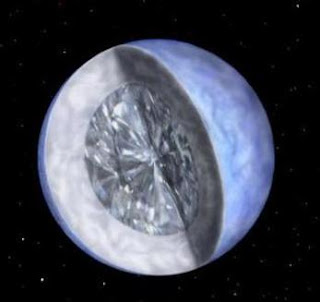 |
| Diamond planet |
The new planet is far denser than any other known so far and consists largely of carbon. Because it is so dense, scientists calculate the carbon must be crystalline, so a large part of this strange world will effectively be diamond.
The discovery was made by a team of researchers from Australia , Germany , Italy , the U.K. and the U.S. , led by the Swine bourne University
 |
The astronomers noticed that the arrival time of the waves from PSR J1719-1438 were systematically modulated and concluded that the gravitational pull of a small companion planet orbiting the pulsar in a binary system was to blame. The modulations tell the astronomers that the planet orbits the pulsar in just two hours and ten minutes, and that the distance between the two objects is 600,000 km - which is a little less than the radius of our Sun. The planet is 4000 light-years away and estimated five times the size of earth. The density is the real giveaway: this planet is 18 times heavier than water.
Moreover, it circles a neutron star. Neutron stars are the corpse of massive stars that blew up, leaving a tiny core of degenerated matter weighing thousands to millions of tons per cubic inch often spinning wildly. It’s far from clear exactly how the world ended up orbiting such an unusual partner. One possibility is the original system was a binary and the companion a star which was denuded of its gaseous envelope in the ancient super nova, leaving behind a core of carbon and oxygen. Or the object could have grown out of the heavy element rich nebula formed by a large exploding star similar to the way scientists believe traditional planets form out of the material surrounding young stars. The planet itself orbits the pulsar in a little more than two hours. The entire system would fit within the diameter of our sun.

No comments:
Post a Comment